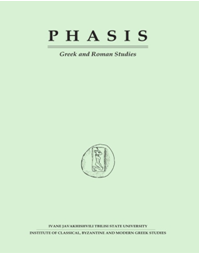The Essence of Heredity and Ancient Heritage in Christian Culture
DOI:
https://doi.org/10.60131/phasis.17.2014.2335Abstract
Inheritability means the transmission of spiritual and material values to future generations. This process stems from the Lord’s creative act – the genesis of the world and man. According to the Book of Genesis, the Lord created man in His image and after His likeness. As Holy Fathers Gregory of Nyssa and John of Damascus comment, God created human mind in His image. It can be therefore construed that the Lord endowed man with creational/artistic faculties and various talents. This grace, including the artistic potential, originates from the Holy Spirit and unites people. However, each creation of God, and respectively, each person is individual and human creations are likewise diverse. An artist endows its creation with unparalleled traits unless he/she purposefully imitates someone else’s work. This originality is the manifestation of the divine grace. However, masterpieces may contain mutually unrelated similarities, as humans create in the likeness of nature created by God, and may perceive and represent some natural shapes in a similar way. Therefore, formal parallels and similar shapes cannot always be attributed to cross-cultural influences and their respective histories need to be studied in depth. A vivid example of such parallels is a close resemblance between cross-shaped ornaments on a Sudanese Slit Drum from the British Museum and the so-called Bolnisi Cross. Though almost identical, they have different origins and cannot be put down to cultural heredity. The article also cites other examples of formal coincidences across cultures. As an opposite case to the above-mentioned accidental parallelism, the paper discusses the influence of ancient culture on Christian art, which frequently may not involve formal identity but is obviously hereditary: this is ancient cultural heritage – Greek and Roman painting, sculptural and architectural traditions adopted by Christian art and filled with the Christian creed.
Downloads
Published
Issue
Section
License
Copyright (c) 2014 PHASIS

This work is licensed under a Creative Commons Attribution-NonCommercial 4.0 International License.


